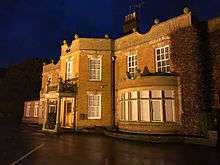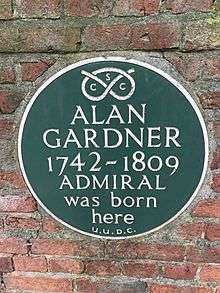Alan Gardner, 1st Baron Gardner
Admiral Alan Gardner, 1st Baron Gardner (12 February 1742 – 1 January 1809), was a British Royal Navy officer and peer of the realm. He was regarded by some as one of the Georgian era's most dashing frigate captains and, ultimately, a respected senior admiral.
The Lord Gardner | |
|---|---|
%2C_by_William_Beechey.jpg) Alan Gardner by William Beechey | |
| Born | 12 February 1742 Uttoxeter, England |
| Died | 1 January 1809 (aged 66) |
| Allegiance | |
| Service/ | |
| Years of service | 1755–1800 |
| Rank | Admiral |
| Commands held | Jamaica Station Leeward Islands Station Cork Station Portsmouth Command |
| Relations | Alan Gardner (eldest son), Robert Barrie (nephew), William Linnæus Gardner (nephew) |
| Other work | MP for Plymouth and, later, Westminster. |
Naval career
Gardner joined the Royal Navy in 1755. Promoted to captain in 1766, his first command was the fireship HMS Raven.[1] He commanded a number of frigates before being promoted to a ship of the line. In 1782 he commanded the 98-gun HMS Duke at the Battle of the Saintes, and in 1786 as commodore of the Jamaica Station (consisting of HMS Europa and HMS Experiment),[2] he suppressed smuggling in the Gulf of Mexico and ordered detailed hydrographic surveys of Caribbean locations of interest to the Navy. During this time, he commanded and probably mentored future famous officers such as George Vancouver, Peter Puget and Joseph Whidbey.[3]
Gardner became a Member of Parliament for Plymouth in 1790 and later for Westminster in 1796. He was appointed to the Board of Admiralty in 1790 and was appointed commander-in-chief of the Leeward Islands Station in 1793.[4] As rear admiral in November 1793, he was among the first officers to articulate a growing conviction in the navy that lemons were the best cure for scurvy and, going against prevailing medical opinion, demanded a supply for his ships. The resulting scurvy-free voyage of HMS Suffolk to India was a crucial element in the Admiralty's decision in 1795 to issue lemon juice as a daily ration in the navy – a policy which drastically minimised outbreaks of scurvy.[5] He left the Admiralty Board in 1795 and was promoted to full admiral. He commanded a squadron during the Mutiny at Spithead in 1797, and Gardner negotiated directly with the mutineers, until he lost his temper, seized a mutineer by the throat and threatened to hang the lot. This nearly led to his own demise at the hands of the mutineers, but cooler heads prevailed.[6]
In 1800 he became commander-in-chief of the Cork Station.[7] That year he was also created Baron Gardner, of Uttoxeter, in the Peerage of Ireland and in 1806 the title of Baron Gardner in the Peerage of the United Kingdom was created for him. He was briefly commander-in-chief of Portsmouth from March to June 1803[8] but returned to the Cork Station after that. In a letter dated May 19, 1803 to Lady Hamilton he is referred to by Lord Nelson as a drinker, saying "... I shall get from him as soon as I can for they say there is much drinking...".[9] In 1807 he was made commander-in-chief of the Channel Fleet and he died in office on 1 January 1809.[7]
His memorial in the south transept of Bath Abbey, where he is interred, states that "The post of Major General of the Marine Forces was purposely created and bestowed on him by His most Gracious Sovereign for the very distinguished part He took in the ever Memorable Battle of the 1st of June 1794".
Family

Gardner was born at the Manor House Uttoxeter, which is commemorated by a plaque. He married Susannah Hyde Gale (c. 1760 – 20 April 1823) on 20 May 1769.[10] She was a Jamaican heiress and the daughter of Francis Gale, a plantation owner, and Susanna Hall.[10] He married Susanna Hyde Gale, daughter and heiress of Francis Gale of Liguania, Jamaica, and widow of Sabine Turner, in Kingston Jamaica on 20 May 1769. They had nine sons and a daughter, and his eldest son, Vice-Admiral Alan Hyde Gardner, succeeded to his titles. The first son, Alan Gardner, 2nd Baron Gardner, became an admiral in the Royal Navy; the second son, Francis, also became an admiral; and the third son William, became a major general.[11]

Gardner's brother, Major Valentine Gardner, served with the 16th Foot during its service in America from 1767 to 1782, and his son (Gardner's nephew) was Colonel William Linnæus Gardner, a British Indian officer, who created Gardner's Horse in 1809.[12][13]
Gardner's sister, Dorothea (Dolly) Gardner Barrie, had a son Robert Barrie who by the patronage of his uncle took part in the Vancouver Expedition. Later in life, Barrie would be knighted and become a rear admiral.[14]
Legacy
An East Indiaman was named after Admiral Gardner; it was wrecked on the Goodwin Sands, 24 January 1809.[15] It was carrying a large number of copper 10 and 20 cash coins minted by the East India Company for circulation in the Madras Presidency.[16] The coins were preserved in tightly sealed barrels and large numbers were retrieved around 1986. They are frequently packaged and sold as inexpensive "shipwreck coins."[17]
References
- Wing, Robert; Newell, Gordon (1979). Peter Puget: Lieutenant on the Vancouver Expedition, fighting British naval officer, the man for whom Puget Sound was named. Gray Beard Publishing. ISBN 0-933686-00-5.
- Cundall, p. xx
- Naish, John (1996). The Interwoven Lives of George Vancouver, Archibald Menzies, Joseph Whidbey and Peter Puget: The Vancouver Voyage of 1791–1795. The Edward Mellen Press, Ltd. ISBN 0-7734-8857-X.
- Haydn, Joseph (13 June 2008). The Book of Dignities: Containing Lists of the Official Personages of the British Empire ... from the Earliest Periods to the Present Time ... Together with the Sovereigns and Rulers of Europe, from the Foundation of Their Respective States; the Peerage of England and Great Britain Original 1851 Digitized by the University of Michigan. Longmans, Brown, Green, and Longmans. p. 279.
- Vale, Brian (2008). "The Conquest of Scurvy in the Royal Navy 1793–1800: a Challenge to Current Orthodoxy". The Mariner's Mirror. 94: 160–175. doi:10.1080/00253359.2008.10657052.
- Dugan, James (1965). The great mutiny. Putnam.
- Laughton 1889.
- History in Portsmouth Archived 27 June 2015 at the Wayback Machine
- "LETTER TO EMMA HAMILTON, ON HIS IMMINENT DEPARTURE ON THE VICTORY". Archived from the original on 10 January 2018.
- "The Gale/Gayle Families of the West Indies (portrait of Susanna Hyde Gale included)". Archived from the original on 13 December 2013. Retrieved 24 September 2012.
- William Courthope ed. Gardner entry p. 323 Debrett's Complete Peerage of the United Kingdom of Great Britain and Ireland. Printed for J.G. & F. Rivington, 1838 – 781 pages. Retrieved from Google Books.
- Chichester 1889.
- "The Royal Tank Regiment Association: Background". Archived from the original on 5 March 2017. Retrieved 3 November 2017.
- Sir Robert Barrie at the Dictionary of Canadian Biography Online
- "Wrecks of the Britannia, & Admiral Gardner, East Indiamen, on the Goodwin Sands, 24 Jan 1809". National Maritime Museum. Archived from the original on 30 September 2007. Retrieved 4 March 2007.
- Soho Mint: The Loss of the Admiral Gardner
- Coin Community
- Attribution
Laughton, John Knox (1889). . In Stephen, Leslie (ed.). Dictionary of National Biography. 20. London: Smith, Elder & Co. p. 430. ; Endnotes:
- Charnock's Biog. Nav. vi. 583
- Ralfe's Nav. Biog. i. 407
- Foster's Peerage
- Jerdan's National Portrait Gallery
Sources
- Cundall, Frank (1915). Historic Jamaica. West India Committee.
External links
| Wikimedia Commons has media related to Alan Gardner, 1st Baron Gardner. |
- Alan Gardner, 1st Baron Gardner, illustrations in the National Maritime Museum
- Alan Gardner, 1st Baron Gardner, illustrations in the National Portrait Gallery
- Alan Gardner at Oxford Dictionary of National Biography
- Heart of Oak: Letters from Admiral Gardner (1742–1809), edited Francis Noel Day, 30 September 2015, ISBN 978-0956934642 – a recently published collection of correspondence
- "Archival material relating to Alan Gardner, 1st Baron Gardner". UK National Archives.

| Parliament of Great Britain | ||
|---|---|---|
| Preceded by Captain Robert Fanshawe Captain John MacBride |
Member of Parliament for Plymouth 1790–1796 With: Captain John MacBride (1790) Sir Frederick Leman Rogers (1790–1796) |
Succeeded by Sir William Elford Sir Frederick Leman Rogers |
| Preceded by Samuel Hood |
Member of Parliament for Westminster 1796–1801 |
Parliament of the United Kingdom |
| Parliament of the United Kingdom | ||
| New parliament | Member of Parliament for Westminster 1801–1806 |
Succeeded by Earl Percy |
| Military offices | ||
| Preceded by John Pakenham |
Commander-in-Chief, Jamaica Station 1785 |
Succeeded by Alexander Innes |
| Preceded by Alexander Innes |
Commander-in-Chief, Jamaica Station 1786–1789 |
Succeeded by Philip Affleck |
| Preceded by Sir John Laforey |
Commander-in-Chief, Leeward Islands Station 1793 |
Succeeded by Sir John Jervis |
| Preceded by Robert Kingsmill |
Commander-in-Chief, Cork Station 1800–1803 |
Succeeded by Not filled |
| Preceded by Mark Milbanke |
Commander-in-Chief, Portsmouth March 1803 – June 1803 |
Succeeded by Sir George Montagu |
| Preceded by Not filled |
Commander-in-Chief, Cork Station 1803–1807 |
Succeeded by James Hawkins-Whitshed |
| Peerage of Ireland | ||
| New title | Baron Gardner of Uttoxeter 1800–1809 |
Succeeded by Alan Gardner |
| Peerage of the United Kingdom | ||
| New title | Baron Gardner of Uttoxeter 1806–1809 |
Succeeded by Alan Gardner |